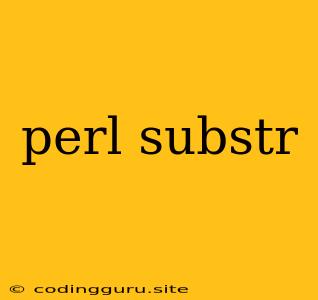Understanding and Using substr in Perl
Perl is a powerful scripting language known for its text manipulation capabilities. One of the fundamental tools for string manipulation is the substr function. This article aims to provide a comprehensive guide on how to effectively use substr in Perl.
What is substr?
substr is a built-in function in Perl that allows you to extract or modify portions of a string. It provides you with the flexibility to handle different string operations like:
- Extracting substrings: Retrieve a specific part of a string.
- Modifying substrings: Replace or update a segment of a string.
- Replacing substrings: Substitute a part of the string with another string.
How to use substr
The basic syntax for using substr is:
substr($string, $offset, $length, $replacement)
Let's break down the parameters:
- $string: The string you want to operate on.
- $offset: The starting position within the string (zero-based). A negative offset counts from the end of the string.
- $length: The number of characters to extract or replace. If omitted, the remaining characters from the offset are affected.
- $replacement: An optional string to replace the extracted portion.
Practical Examples
1. Extracting a Substring:
$message = "Hello, World!";
$greeting = substr($message, 0, 6);
print "Greeting: $greeting\n"; # Output: Greeting: Hello,
In this example, we extract the first 6 characters from the $message string.
2. Modifying a Substring:
$name = "John Doe";
substr($name, 5, 4) = "Smith";
print "New name: $name\n"; # Output: New name: John Smith
Here, we replace the last 4 characters of the $name string with "Smith".
3. Replacing a Substring:
$sentence = "The quick brown fox jumps over the lazy dog.";
$sentence =~ s/brown/red/;
print "New sentence: $sentence\n"; # Output: New sentence: The quick red fox jumps over the lazy dog.
In this example, we use the s/// operator to replace the substring "brown" with "red".
Understanding substr in Different Scenarios
1. Negative Offset:
Negative offsets count from the end of the string. For example, to extract the last 5 characters of a string:
$text = "This is a test.";
$last_chars = substr($text, -5);
print "Last 5 characters: $last_chars\n"; # Output: Last 5 characters: test.
2. Omitting length:
If you omit length, substr operates on the rest of the string from the offset.
$url = "https://www.example.com";
$domain = substr($url, 8);
print "Domain: $domain\n"; # Output: Domain: www.example.com
3. substr with length 0:
When you use length 0, substr will insert the replacement string at the specified offset.
$phrase = "Hello world!";
substr($phrase, 5, 0) = "beautiful ";
print "New phrase: $phrase\n"; # Output: New phrase: Hello beautiful world!
Advanced Applications of substr
- String Parsing:
substrcan be used to break down strings into individual components, like parsing a date string into day, month, and year. - Data Validation: You can use
substrto verify the format of input data, such as checking the length of a password or the structure of an email address. - Data Extraction:
substris valuable for extracting specific information from files or strings, like extracting the filename from a file path.
Important Considerations
- String Manipulation:
substrmodifies the original string directly, so be careful when working with strings you need to preserve. - Zero-Based Indexing: Always remember that Perl uses zero-based indexing, so the first character is at index 0.
- Error Handling: Use
lengthappropriately to avoid accessing out-of-bounds characters.
Conclusion
substr is a powerful tool in Perl for string manipulation. By understanding its syntax and various applications, you can easily extract, modify, and replace parts of strings to meet your programming needs. Mastering substr will significantly enhance your ability to work with textual data in your Perl programs.
